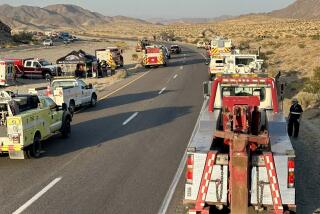The open road
- Share via
The Newhall Pass disaster that claimed three lives, destroyed many big rigs and shut down Southern California’s principal highway connection with the rest of the state might easily have overwhelmed the region. Fires and explosions in a southbound truck tunnel beneath the Golden State Freeway are thought to have raised temperatures above 1,000 degrees, reducing some vehicles to skeletal frames after melting metal and glass.
With the closing of the truck route, the supply chain of goods to and from Los Angeles was severed from the north. What’s more, the shutdown of the automobile route overhead meant the prospect of nightmarish commutes for the motorists who daily make the trip to the L.A. basin from hilly suburbs that stretch into the San Joaquin Valley.
Given the magnitude of the mess, the speed with which Los Angeles County firefighters rescued survivors, doused the flames and turned the tunnel over to inspectors from the California Department of Transportation -- who in turn cleared the way for Caltrans workers to shore up supports and reopen the freeway to traffic -- was remarkable. The fact that motorists could use Interstate 5 on Monday morning, in both directions, is a testament to quick and coordinated work from state and local agency managers and heroic efforts by workers on the pavement. Who would have thought that our government could work so well?
The impressive efforts by rescue and transportation workers should not come as a surprise. A tanker truck crash in April that shut down a key East Bay interchange known as the MacArthur Maze was expected to tie San Francisco Bay Area traffic in knots for months. Instead, Caltrans had ramps opened within days, and the entire mess corrected within a month.
Under Director Will Kempton, the agency has quickly moved from the butt of jokes to something very near a model of government efficiency and responsiveness. Voters and taxpayers should remain vigilant as the agency puts record levels of bond funding to work, but the necessary and natural suspicion can perhaps be accompanied by a grateful salute.
Meanwhile, it is reassuring to be reminded that county firefighters, well known for their skill in battling brush and forest fires, can respond so quickly to a more urban disaster. Los Angeles’ crucial transportation network is extraordinarily vulnerable to disruption by earthquake, terror attack or other disaster, and the work of rescue workers in a comparatively small crisis like Friday’s offers hope that the county will be able to pull through when the inevitable cataclysm strikes.
More to Read
Sign up for Essential California
The most important California stories and recommendations in your inbox every morning.
You may occasionally receive promotional content from the Los Angeles Times.










